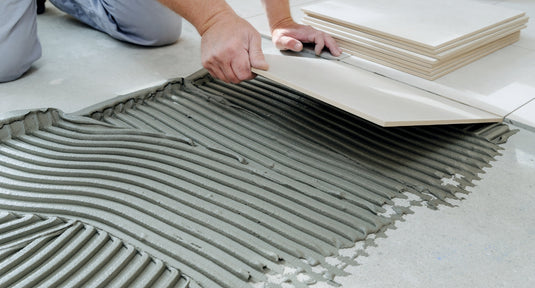Waterproof bath seal at a glance
Generally speaking, the bathroom waterproofing is the process of protecting your bathroom and wet areas using various methods. Suitable sealing measures ensure that water cannot penetrate the building structure.
In connection with tiles or other slab coverings, one speaks of the so-called composite waterproofing in the bathroom.This always consists of several layers and components such as tile adhesive, sealing mats or liquid foil as well as accessories such as sealing tapes and cuffs.
Function of the waterproof seal
- The bathroom waterproofing prevents moisture from penetrating walls and floors
- Mold formation in the masonry is avoided
- The service life of the building structure is increased
- Mat systems also have insulating properties
- Adjacent rooms are protected from moisture damage
- Sealing mats provide a secure foundation for tiles and other floor coverings.
In the blog "Bathroom sealing: protection against moisture and mold"you will find further information on this topic.
Different methods for waterproofing seal
One can distinguish between liquid waterproofing for the bathroom and mat systems consisting of sealing membranes. Each method has different advantages. To help you decide which is best for you, here are some characteristics of the methods.
Sealing the bathroom with sealing mats
Sealing membranes are usually made of polyethylene foil and are attached to the wall with tile adhesive. The processing is a little more complex, but the tiles can be installed immediately after laying. A big advantage of sealing mats is the high tear resistance, which ensures long-term sealing. Thanks to the matching molded parts, they are also easy to adapt to different room shapes and corners.
Self-adhesive waterproof seal
A special and quite new form of sealing membranes has a self-adhesive back. This type of sealing brings with it a number of advantages that should not be neglected when deciding which method is best for you. First of all, there is the time factor. As no glue has to be applied and no drying times have to be taken into account as with liquid foil, the working time is reduced massively. Last but not least, laying self-adhesive sealing membranes causes less dirt than with the other methods. You can read more about this in the blog post "Self-adhesive sealing in the bathroom" for further information.
Liquid sealing with liquid foil
Liquid foil is applied with a brush, which makes it very easy to use. The uncomplicated processing makes it suitable for areas that are difficult to access. It is also ideal for small repairs or additions, as it is flexible and easy to apply. A major disadvantage compared to mat systems is the long drying time, which can take up to 24 hours. Only then can you start tiling.
Waterproof bath seal according to DIN 18534
In DIN 18534 the sealing of interior spaces is described. Only if all points are fulfilled, the sealing method can be called standardized. The various points include:
- Classification into water impact classes (W0-I to W3-I.
- Sealing materials must be tested and approved. Accessories such as sealing tapes or sleeves must be used in a system-specific manner.
- The waterproofing layer must be at least two layers.
- Wall seals must extend 5 cm above the floor. For floor-level showers, at least 20 cm above the highest tap.
- Shower trays and bathtubs must be specially protected by special tub sealing tapes
- Floor drains and channels must have a flange width of 50 mm
- The sealing must be continued behind door frames and connecting joints
Tile composite sealing in the bathroom - our systems
With the self adhesive shower waterproof membrane and the associated accessories, you will find an exceptional sealing system of the highest quality with us. It is particularly worth mentioning that all components are self-adhesive, which speeds up the processing considerably. Standard-compliant sealing in record time.
The shower waterproofing membrane ET-S with matching accessories is another mat system for bathroom sealing that you can find with us. This also ensures sealing in accordance with DIN18534.
To make sure everything goes right with your bathroom waterproofing, we recommend the article"The 5 most common mistakes when sealing bathrooms"in our guide
